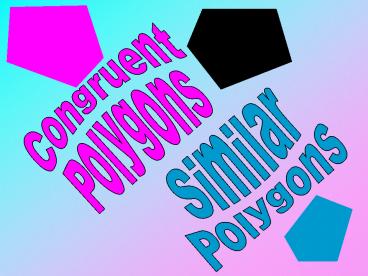Congruent
1 / 8
Title: Congruent
1
Congruent Polygons
Similar Polygons
2
Congruent polygons are polygons that are the same
size and same shape. They arise from isometric
transformations otherwise known as isometries.
These transformations preserve length and angular
measurement. There are 3 types of isometries
ROTATIONS
TRANSLATIONS
REFLECTIONS
Notice that the sides of the corresponding are
congruent and so are the corresponding angles.
3
To prove that 2 polygons are congruent correspon
ding sides must be congruent
corresponding angles must be congruent
If just one of these turns out not to be the case
then the polygons are not congruent.
4
As a result of 2 polygons being congruent there
are 4 consequences corresponding sides are
congruent corresponding angles are
congruent perimeters are equal areas are equal
5
Similar polygons are polygons that are the same
shape but not the same size. They arise from
transformations of similitude and are sometimes
referred to as dilatations. They can be
enlargements or reductions. These transformations
preserve angular measurement and the ratio of
corresponding sides remain constant.
6
To prove that 2 polygons are similar ratios of
corresponding sides must be equal
corresponding angles must be congruent
ABCDE FGHIJ
If just one of these turns out not to be the case
then the polygons are not similar.
7
As a result of 2 polygons being similar there are
4 consequences ratio of the corresponding
sides are equal
corresponding angles are congruent
ratio of the perimeters equals ratio of
corresponding sides
ratio of the areas equals the square of the
ratio of the corresponding sides
8
It is not just plane figures that can be
congruent and similar so can solids like cubes,
prisms, cylinders, cones, etc.
When 2 corresponding solids are congruent, it
means they have the same size and shape and we
can make the following conclusions corresponding
segments are congruent areas are equal volumes
are equal ratio of lengths of corresponding
sides equals 1 (k 1)
When 2 corresponding solids are similar, it means
they have the same shape and we can make the
following conclusions corresponding segments
are proportional ratio of areas is equal to the
square of the ratio of lengths of corresponding
sides ratio of volumes is equal the cube of the
ratio of lengths of corresponding sides































